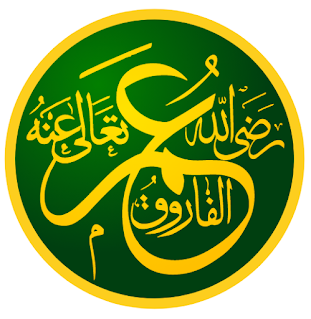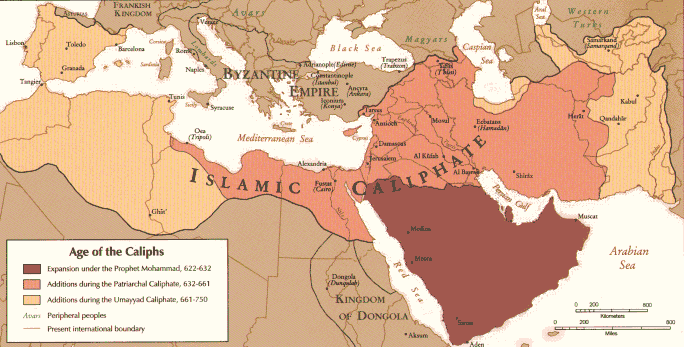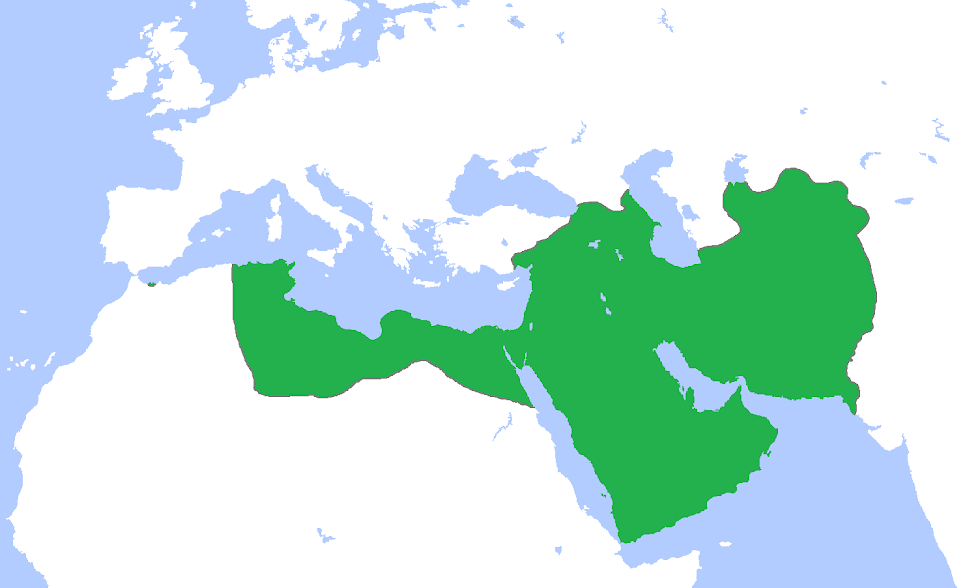Abu Yusaf Yaqub ibn Ishaq Al-Kindi (c. 801 - c. 873) was the ninth-century Arab polymath at the peak of the Abbasid dynasty (c. 750 - c. 1258). He belongs to the famous Arab tribe of Kinda and descendent of al-Ash'ath ibn Qays al-Kindi, a companion of Prophet Muhammad who had also close marital relationships with the 1st and 3rd caliphs Abu Bakr and Usman besides his supporting role for the fourth caliph, Ali ibn Abi Talib against Mawaiya (first Umayyad king) at the Battle of Siffin (656). Al-Kindi extensively interacts with several fields such as Mathematics, Medicine, Chemistry, Astronomy, Astrology, Optics, Zoology, Meteorology, Logic, Ethics, Metaphysics, and Islamic Theology.
He is widely known for his 10 major academic accomplishments regarding Philosophy and Science.
Cryptanalysis: He is generally regarded as the "father of Cryptography" because he was the first to develop a method whereby variations in the frequency of the occurrence of letters could be analyzed and exploited to break ciphers (i.e. cryptanalysis by frequency analysis). This method can be described in his book called Risala fi Istikhraj al-Kutub al-Mu'ammah (رسالة في استخراج الكتب المعماة - On Extracting Obscured Correspondance).1
Algorithm: He is also considered as the "father of algorithm/modern mathematics" along with al-Khawarzmi because of his use of Indian Numerals in his book named (Ketab fi Isti'mal al-Adad al-Hindi) which greatly contributed to the diffusion of Indian numerals in the Islamic world and then West.2 He wrote many essential works on mathematical subjects related to arithmetic, geometry, the Indian numbers, the harmony of numbers, lines, and multiplication with numbers, measuring the proportion and time, relative quantities, and numerical procedures and cancellation. As a mathematician, he also used mathematics to disprove the philosophical concept of eternity of the world.3
Distillation: As a well-established chemist, he opposed the alchemy; he debunked the myth that simple, base metals could be transformed into precious metals such as gold or silver.4 He also describes the process of distillation of wine in his book of Kitab al-Tarafffuq fi al-Itr (The Book of chemistry Perfume and distillations). In this same book, he also describes the distillation process for the rose oils, and provide the recipes for 107 various types of perfumes. For that reason, he is also sometimes referred to as the "father of modern perfumery" because he was the first to carry out extensive research and experiments in combining various plants and other sources to produce a variety of scent products.5
Potency: He wrote more than 30 treatises attributed to al-Kindi in the subject of medicine. As an advanced mathematician, he was chiefly responsible for developing a scale to quantify the potency of the drug and a system, based on the phases of the moon, that would enable a doctor to ascertain in advance the most crucial days of a patient's illness. This was the first-ever serious attempt in the quantification of medicine.6
Optics: After Ptolemy, al-Kindi was the first writer on optics. In his theory, he said that "everything in the earth.... emits rays in every direction, which fills the entire earth". His theory of active power rays had also influenced the later physicist such as Ibn al-Haytham, Robert Grosseteste, and Roger Bacon.7
Theory of Tides: In meteorology, he gave the theory of tides in his treatise "Risala fi l-llla al-Failali I-Madd wa I-Fazr (Treatise on the Efficient Cause of the Flow and Ebb) to define the changes in the bodies due to the rise and fall of temperature and he proved through his experiment that how extreme cold air changes into water.8 Moreover, he also describes the cause of wind, and the difference of direction based on time and location, he wrote "When the sun is in its northern declination northerly places will heat up and it will be cold towards the south. Then the northern air will expand in a southerly direction because of the heat due to the contraction of the southern air. Therefore, most of the summer winds are substantive and most of the winter winds are not."9
Synchronization of Philosophy with Islamic Theology:
His greatest contribution to the field of philosophy was to harmonize the Hellenistic philosophy with Islamic theology. He was the first Peripatetic philosopher in the Muslim world, known as the "father of Arab/Islamic Philosophy".10
Astronomy: Al-Kindi believed and wrote in his treatise that heavenly bodies are rational entities, whose circular motion is in obedience to and worship of God. He believed that their role is to act as instruments for divine providence. He furnishes empirical evidence as proof for this assertion, different seasons are marked by a particular arrangement of heavenly bodies situated above their homeland. This idea is perfectly correct within the context of Quranic verses such as one in the chapter al-Hajj verse 18:
Do you not see that to Allah bow down (in worship all things) the heavens "Lofty waters/Membranes" and on land "Physical Universe"― the sun, the moon, the stars; the hills, the trees the animals; and many within mankind? and many are (also) fit for Punishment: and whosoever Allah shall disgrace none shall raise him to honor: that Allah does whatever he wants. (22:18)
Metaphysics: Al-Kindi realized the goal of metaphysics is to attain the knowledge of God. For this reason, he wasn't made any distinction between philosophy and theology. Al-Kindi understands three major attributes of God, (1) Absolute oneness (2) Creator, and (3) Agent. All of his three major metaphysical ideas are in complete alignment with Quran's verses. Chapter Al-Ikhlas clear and concisely mentions Allah's absolute oneness:
Underlying these two verses completely explains the idea of God as the ultimate creator of everything:
Praise be to Allah Who created the heavens and the earth, Who made the angels Messengers with wings― two, or three, or four (Pairs): He adds to Creation as He pleases: for Allah has power over all things. (35:1)
In blasphemy indeed are those that say that Allah is Christ, the son of Mary. Say: "Who then hath the least power against Allah, if His Will were to destroy Christ the son of Mary, his mother, and all― everyone that is on the earth? For to Allah belong the dominion of the heavens and the land and all that is between. He creates what He, please. Allah had power over all things." (5:17)
Al-Kindi also proposes the idea of God as an active agent that acts through created intermediaries, which in turn act on one another - through a chain of cause and effect - to produce the desired results. Chapter Al-Anaam verse 65 perfectly harmonize with this concept:
Say: "He has the power to send calamities on you, from above and below, or to cover you with confusion in party strife, giving you a taste of mutual vengeance― each from the other." See how We explain the Signs by various (symbols) that they may understand. (6:65)
The Soul and the Afterlife: Al-Kindi's concept of soul and the afterlife are similar to the primary held idea of Islamic theology regarding the soul as the simple, immaterial substance embedded with the material world for a brief period. Quranic verses clearly gave an idea towards the nature of the soul as an immaterial substance connected through a physical realm momentarily, particularly verse 29 of Al-Hijir describes the creation of Adam:
Behold! Thy Lord said to the angels: "I am about to create man, from sounding clay from mud molded into shape; "When I have fashioned him and breathed into him of My Soul, fall you down in obeisance unto him." (15:28-29)
Al-Kindi considered revelation and philosophy are two separate routes for arriving at the truth. To make a distinction, he differentiates the two positions in four ways. Firstly, a specific person who undergoes a long period of training and study to become a philosopher, prophecy on the other hand is bestowed upon someone by God. Secondly, the philosophers have arrived at the truth through personal efforts, whereas the prophet has the truth revealed to him by God. Thirdly, the understanding of the prophet - being divinely revealed - is clearer and more extensive than that of a philosopher. Fourthly, the expression of understanding by the prophet in delivering the message to the public is superior. Consequently, al-Kindi says the prophet is superior in two areas: the ease and certainty with which he receives the truth and how he presents it but the content of prophet's and philosopher's knowledge is the same.
These four ideas are accurately correct within the Quranic frame of reference. There is a well-known example of prophet Abraham who before revelation reflected on God's nature and comes to the conclusion that the sun, moon, stars, and even everything else created by one Al-Mighty, God. This story is mentioned in chapter Al-Anaam:
So also did We show Abraham the kingdom of the heavens and the earth that he might have certitude. When the night covered him over, he saw a celestial object: he said: "This is my Lord." But when it set, he said: "I love not those that set." When he saw the moon rising in splendor, He said: "This is my Lord." but when the moon set he said: "Unless my Lord guides me I shall surely be among those who go astray." When he saw the sun rising in (splendor) he said: "This is my Lord; this is the greatest (of all)." But when the sunset he said: "O my people! I am free from your (guilt) of giving partners to Allah. "For me, I have set my face, firmly and truly, toward Him Who created the heavens (Membranes/Lofty Waters) and the land (Physical Universe), and never shall I give partners to Allah." (6:75-79)
This is the perfect example of being both a philosopher and a prophet when Abraham ponders upon nature and try to figure out the reality. As a result of his accurate observation and clever thinking, he came up with an outcome that there is only one transcendent, the incorporeal entity in the cosmos - responsible for every creation. But here a crucial point needs to be noted that there is a misconception concerning al-Kindi's idea that he devalued the superiority of revelation by saying that the content generated from both philosophy and prophecy are similar. The understandable part is that what does content means, according to al-Kindi. The content which al-Kindi describes the notion of ultimate reality, particularly about the knowledge of God. The previously best example of this verse clearly sheds light on this matter. Abraham, before the revelation, adopted monotheism, simply by querying and inquiring the nature, eventually finds out the answer. As a result, the (ultimate/primary) content that he gains from the quest concerning the attributes of God's Absolute oneness, Creator, and being as an Agent are the same as the prophets foretold to the people about God's attributes.
Al-Kindi was generally criticized for his pro-Mutazilite approach which is invalid. He involved in arguments with the Mutazilities whom he attacked for their belief in atoms. In his time, he would be blamed for praising the "intellect" as being the most immanent creation in proximity to God, which was commonly held to be the position of the angels. At that point, all critics misunderstood the meaning of "intellect" which al-Kindi spokes about. Everything in the universe is created from the cosmic code similar to binary digits (0/1). This machine language is actually codified in the form of binary digits across the cosmos and gives meaning to every creation. This is called "First Intellect" or "Information". This idea is supported by three different Quranic verses:
To Him is due to the primal origin of the heavens (lofty waters-universes) and the land; when He decrees a matter, He said to it: "Be" (كُن فَيَكُونُ/0 , 1), and it is. (2:117)
It is He Who created the heavens (lofty waters/universes) and the land in true (proportions): the day He said "Be" (كُن فَيَكُونُ/01) Behold! it is. His Word (information) is the truth. His will be the dominion the day the trumpet will be blown. He knows the Unseen as well as that which is open. He is the Wise, well acquainted (with all things). (6:73)
"Is not He Who created the heavens (lofty waters/universes) and the land able to create the like thereof?"― Yea, indeed! He is the Creator Supreme, of skill and knowledge (infinite)! Verily, when He intends a thing, His command is "Be" (كُن فَيَكُونُ/01), and it is! So glory to Him in Whose hands is the dominion of all things; and to Him, you will be brought back. (36:81-83)
It is He Who gives Life and Death, and when He decides upon an affair, He says to it, "Be" (كُن فَيَكُونُ/01), and it is. (16:40)
No doubt, al-Kindi was one of the great scientific minds of all time. His influence lasted for several centuries after his death in the fields of mathematics, medicine, physics, chemistry, and philosophy. He was also a significant figure in medieval Europe. His several books got translated into Latin which eventually influenced western authors such as Robert Grosseteste and Roger Bacon. The Italian Renaissance scholar Geralomo Cardan0 (1501 - 1575) considered him as one of the twelve greatest minds.













